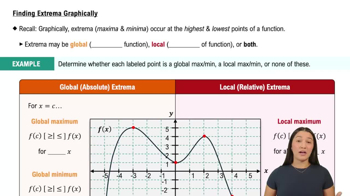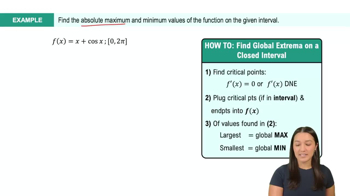Table of contents
- 0. Functions7h 52m
- Introduction to Functions16m
- Piecewise Functions10m
- Properties of Functions9m
- Common Functions1h 8m
- Transformations5m
- Combining Functions27m
- Exponent rules32m
- Exponential Functions28m
- Logarithmic Functions24m
- Properties of Logarithms34m
- Exponential & Logarithmic Equations35m
- Introduction to Trigonometric Functions38m
- Graphs of Trigonometric Functions44m
- Trigonometric Identities47m
- Inverse Trigonometric Functions48m
- 1. Limits and Continuity2h 2m
- 2. Intro to Derivatives1h 33m
- 3. Techniques of Differentiation3h 18m
- 4. Applications of Derivatives2h 38m
- 5. Graphical Applications of Derivatives6h 2m
- 6. Derivatives of Inverse, Exponential, & Logarithmic Functions2h 37m
- 7. Antiderivatives & Indefinite Integrals1h 26m
- 8. Definite Integrals4h 44m
- 9. Graphical Applications of Integrals2h 27m
- 10. Physics Applications of Integrals 2h 22m
5. Graphical Applications of Derivatives
Finding Global Extrema
Problem 4.1.61
Textbook Question
Absolute maxima and minima Determine the location and value of the absolute extreme values of ƒ on the given interval, if they exist.
ƒ(x) = x/(x²+9)⁵ on [-2,2]
 Verified step by step guidance
Verified step by step guidance1
First, understand that absolute maxima and minima refer to the highest and lowest values of a function on a given interval. To find these, we need to evaluate the function at critical points and endpoints of the interval.
Find the derivative of the function ƒ(x) = x/(x²+9)⁵. Use the quotient rule, which states that if you have a function g(x)/h(x), its derivative is (g'(x)h(x) - g(x)h'(x))/(h(x))².
Set the derivative equal to zero to find critical points. This involves solving the equation derived from the derivative for x. Critical points occur where the derivative is zero or undefined.
Evaluate the function ƒ(x) at the critical points found in the previous step, as well as at the endpoints of the interval, x = -2 and x = 2.
Compare the values of ƒ(x) at these points to determine the absolute maximum and minimum values on the interval [-2, 2]. The largest value will be the absolute maximum, and the smallest will be the absolute minimum.
 Verified video answer for a similar problem:
Verified video answer for a similar problem:This video solution was recommended by our tutors as helpful for the problem above
Video duration:
7mPlay a video:
Was this helpful?
Key Concepts
Here are the essential concepts you must grasp in order to answer the question correctly.
Absolute Extrema
Absolute extrema refer to the highest and lowest values of a function on a given interval. To find these values, one must evaluate the function at critical points, where the derivative is zero or undefined, as well as at the endpoints of the interval. The largest of these values is the absolute maximum, while the smallest is the absolute minimum.
Recommended video:

Finding Extrema Graphically
Critical Points
Critical points are values of the independent variable where the derivative of the function is either zero or does not exist. These points are essential for finding absolute extrema, as they indicate where the function may change direction. To locate critical points, one must first compute the derivative of the function and solve for when it equals zero or is undefined.
Recommended video:

Critical Points
Closed Interval Method
The closed interval method is a technique used to find absolute extrema of a function on a closed interval [a, b]. This method involves evaluating the function at the endpoints of the interval and at any critical points found within the interval. The absolute maximum and minimum values are then determined by comparing these function values.
Recommended video:

Intro to Applied Optimization: Maximizing Area
Related Videos
Related Practice









